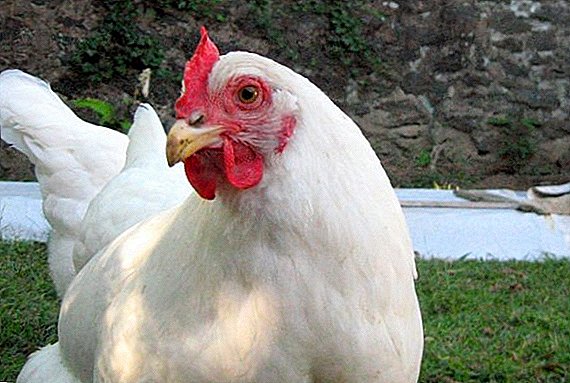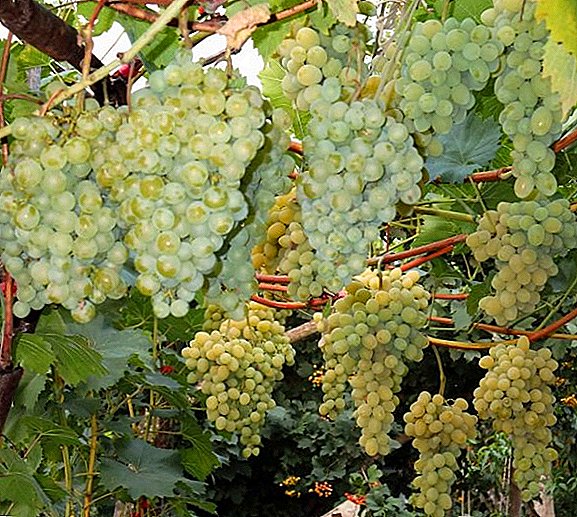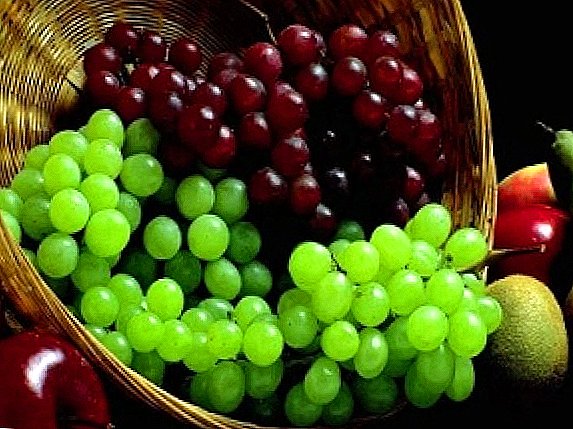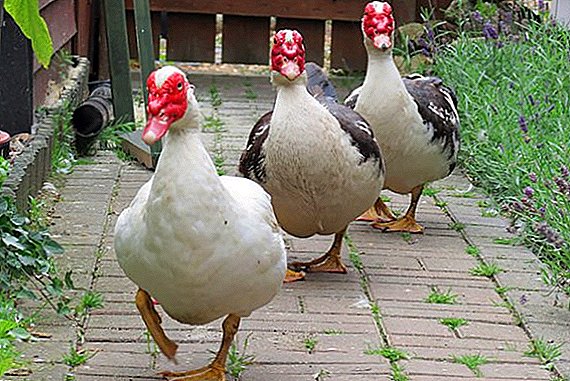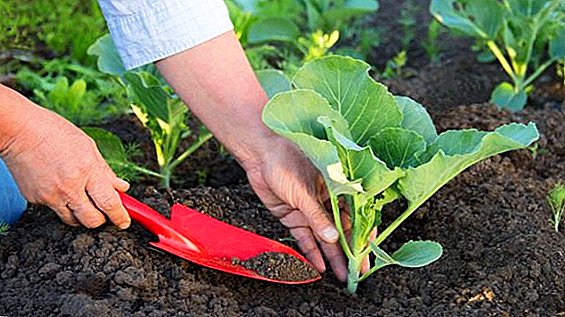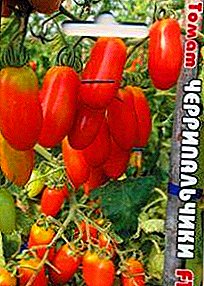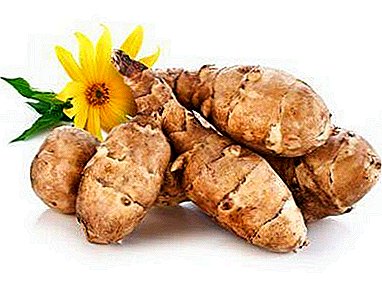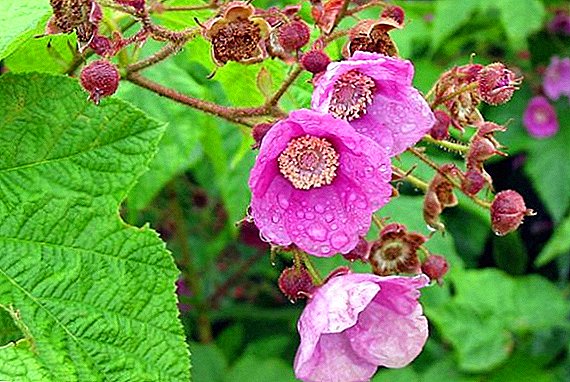 Rubus odoratus or fragrant raspberry (Pink family) is an ornamental shrub with large sweet-sour fruits.
Rubus odoratus or fragrant raspberry (Pink family) is an ornamental shrub with large sweet-sour fruits.
It is quite rare and is not so easy to find.
At the same time, many gardeners already have such a plant in their plot, but do not even suspect it.
Let's find out how it looks and what care it requires.
Botanical description
The bush grows in the wild by more than 2 m in height, while domesticated specimens usually reach 1.2–1.5 m. In the autumn period, the bark acquires a brown-brown color, but still brightens in spring. 
Shoots this plant is devoid of thorns. Young shoots have a hairy structure and a pleasant aroma, which can remain on the hands for a while after touching.
Raspberry leaves outwardly reminiscent of maple (so the people called her "Malinoklen"). They are simple, three- or five-bladed, have a bright green color and a hairy surface. The width varies from 10 to 20 cm. The leaves are arranged on long petioles. In the fall they turn yellow.
Flowers 6 cm in diameter, have 5 petals. Color - rose red or crimson. Fluffy stamens appear golden. The flower itself is fragrant.
Reddish fruit up to 2 cm in size have a pleasant sweet-sour taste.
The growing season lasts from April to October. The flowering period begins in June and lasts until the first months of autumn. 
Distribution and habitat
Homeland raspberry fragrant is North America. Now this species is also found in Europe and Russia. Favorite place of wild shrubs - mountain slopes and forest thickets.
Using
This raspberry is often used for making compotes in combination with cherries, currants and other berries. They make a very fragrant jam.
Learn how to make jam from apples, from tangerine slices, from black currant, from pumpkin with orange, from grapes, from cowberry, from cornel, from quince, from white cherry, from feijoa.
Also, the shrub can be part of the landscape composition.
Important! Leaves and shoots can be used to prepare cold and bronchitis remedies due to their high content of essential oils.Its powerful root system allows the plant to be used to strengthen sandy slopes and form a hedge.

Agrotechnical cultivation and plant care
For fragrant raspberries is not so difficult to care for. The main thing is to study before planting all the features of this process and reasonably approach the choice of location and soil.
Familiarize yourself with the features of cultivation and such ornamental shrubs as cinquefoil, amorpha, collar, guelder rose, wintergreen, lilac, birch spiraea, zeanotus, rhododendron.
Conditions of detention
This plant loves sunshine. But for planting and fit a slightly darkened place, if absolutely no light area was found. Of course, this will affect the level of yield, but the plant will still be able to survive.
One of the advantages of fragrant raspberries - it is patient to any neighbors.
It should be planted in open soil, on a cultivated plot, in a hole of 20 × 20 cm in size with previously applied fertilizers. The best time for this is autumn or mid-spring. 
Soil and fertilizer
Raspberry is also not whimsical to the soil. Fertile, non-acidic soils are best suited. It is recommended to further fertilize the soil before planting.
The plant is fed with rotted organic fertilizers (half a bucket of manure for each bush) at the beginning of the season, and in the second half of summer - ashes (2 tablespoons). Ready mixes can also be used: nitrogen, phosphorus and potassium.
Experienced gardeners often fertilize in three stages:
- At the beginning of the season - 1 tbsp. l azofoski on 10 l of water.
- During the flowering period - double superphosphate (for 3 bushes - 2 tablespoons. Mixed with a bucket of garden soil) and potassium sulfate (for 4-5 bushes - 2 tablespoons. Dissolve in 1 bucket of water).
- After the fruiting period - 1 tbsp. l potassium sulfate in 10 liters of water, or autumn fertilizers (ready mix).

Watering and moisture
Fragrant raspberry - lover of water. Watering the soil should be regular. It is better not to pour water on the shoots, but to moisten the soil.
Important! The plant does not tolerate stagnant water. This may be one of the reasons for his death.
Relation to temperature
This plant has a high winter hardiness, that is, harsh winters are not afraid of it. Only in the Far North fragrant raspberry can freeze slightly without additional shelter. But with this easy to handle with the help of spring pruning.
In addition, shrub shelter may be needed if the winter is frosty enough, but the snow is almost absent or too little to save the plant. To be absolutely sure that it will survive the winter, it is recommended to bend down and pin the shoots to the ground. 
Reproduction and planting
Raspberries are propagated with parts of the bush or as root shoots in spring (in April) or in autumn (until mid-October). Immediately after planting, all shoots are shortened to a height of 30 cm. Do not forget about watering and feeding young seedlings.
Seed propagation is also possible, but not very effective. The percentage of their germination is low, and you will have to wait for a long harvest from them.
Shaping and trimming
Forming a beautiful bush includes:
- rationing root growth;
- removal of weak and dry branches;
- pruning shoots in the spring.

Did you know? In folk tales, proverbs and sayings raspberry - a symbol of happiness and prosperity. "Not life, but raspberry".
Leave no more than 7 healthy shoots in each bush. Weak and dry branches should not be at all. Overwintered shoots in spring should be shortened by 25 cm from the top. If you do not carry out such manipulations, then raspberries will flood the entire surrounding area.
Harvesting and storage of raw materials
For harvesting berries must be collected only in dry and sunny weather. After harvesting, pour them with salted water for a short time to remove insects that may live inside the raspberries. Next, you need to immediately proceed to processing.
The simplest preparation - raspberry, ground with sugar. After grinding the berries with sugar (sugar 2 times more than the fruit), the mixture should be frozen. You can freeze them and whole, sprinkled with sugar, or cook jam. 
Possible difficulties in growing
If you do not forget about the root growth and pruning of dry shoots, no difficulties with the shrub should arise. The risk of planting death is negligible - on the contrary, without proper control, raspberries can grow on the entire plot and clog other cultures.
Pests, diseases and prevention
Fragrant raspberry is resistant to diseases and pests. No treatments (including prophylactic) are required. If you do not live in an excessively humid climate, then the only bad thing that can happen is the blackening of the shoots. This happens because of the harsh winter winds, but after a while the bush adapts to them.
If your area is characterized by wet summer, the plant may suffer from gray rot. It can be handled with Bordeaux fluid. Of the pests are: raspberry fly, stem gallitsa and raspberry beetle. 
- If the plant is afflicted by a crimson fly, it is recommended to dig up the ground beneath it, burn the foliage discarded by it, cut off the affected tops of the shoots and bloom the soil. Of the aggressive methods are used such drugs as "Spark", "Confidor", "Fitofarm", etc.
- You can cope with the raspberry beetle by spraying the bushes with manganese solution (0.5 g per bucket of water), as well as using the Fitoverm, Fufanon, Confidor or Kinmiks preparations.
- Stem gallitsa is eliminated by such preparations as Fufanon, Karbofos, Ridomil, etc. Additionally, it is recommended to remove and burn the affected areas of the shoots.
Did you know? ANDhigh copper content raspberry is considered an antidepressant. It helps to cope with the oncoming stress.

Fragrant raspberry - the owner of maple-like leaves, fragrant flowers and large fruits. It is undemanding in the care of the bush, resistant to frost, disease and pests. The shrub can be used as a garden decoration or to create a hedge. Its fruit produces fragrant jam, and the leaves and shoots can be a raw material for medicines. Therefore, look at your plants more closely - perhaps you are already the owner of such a treasure in your garden.


